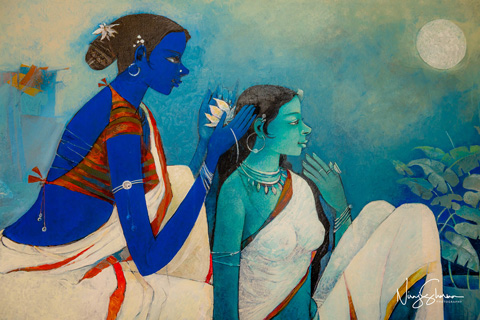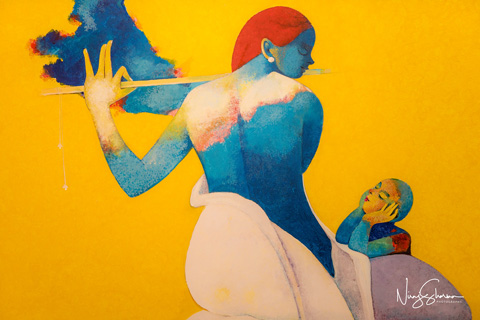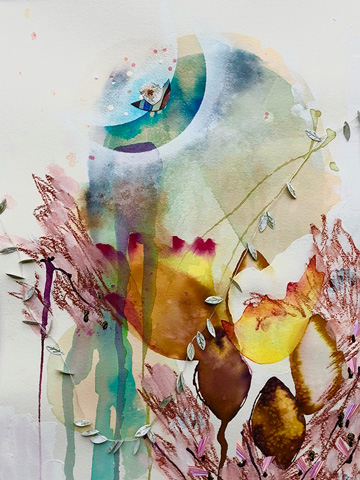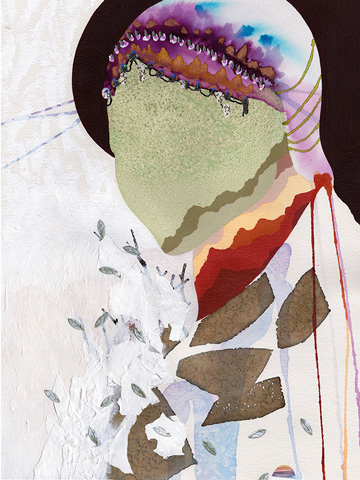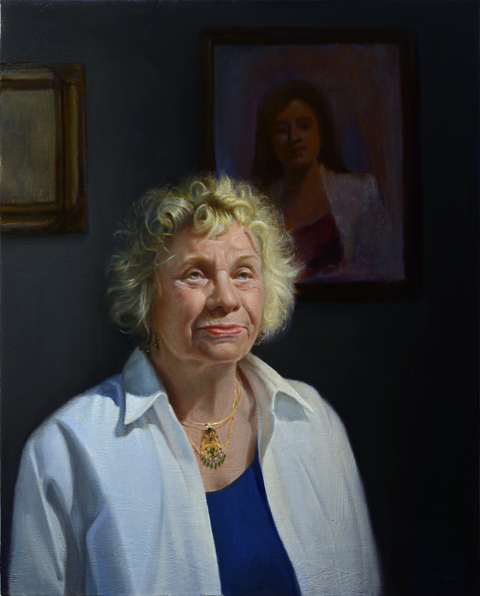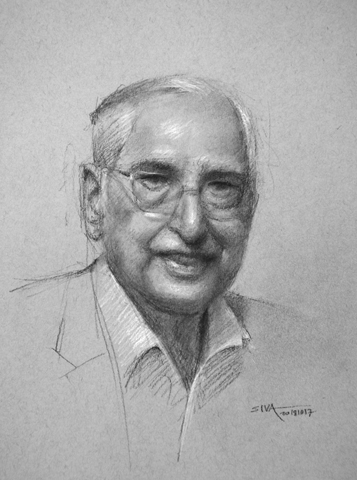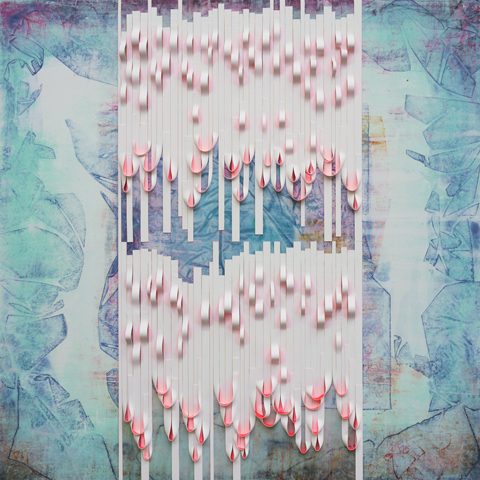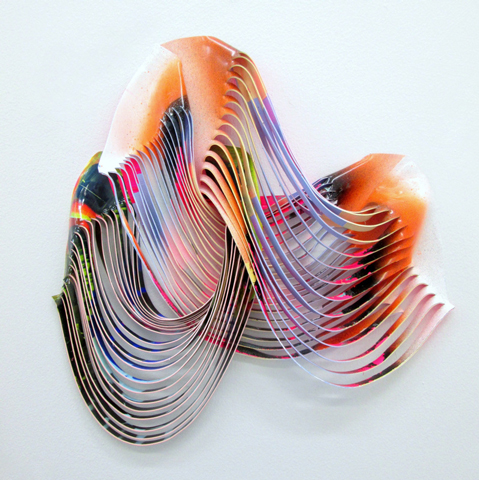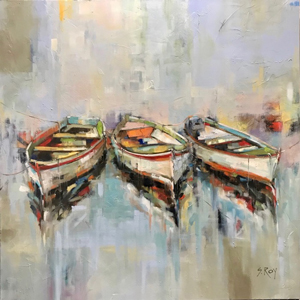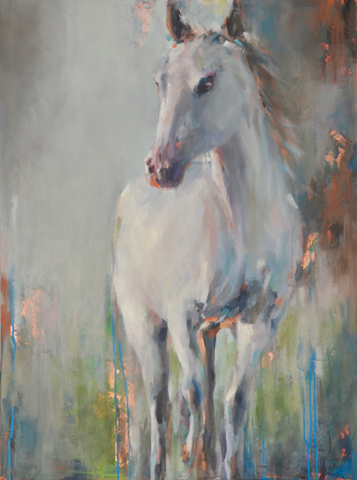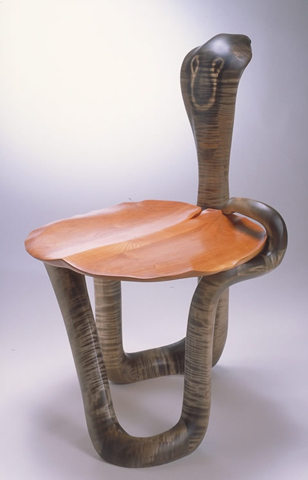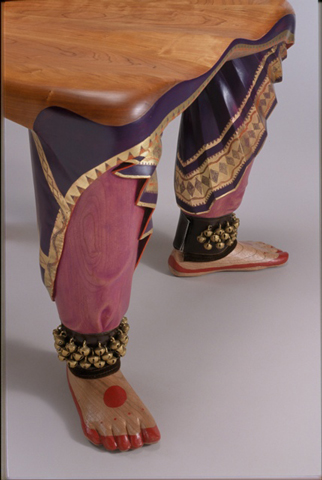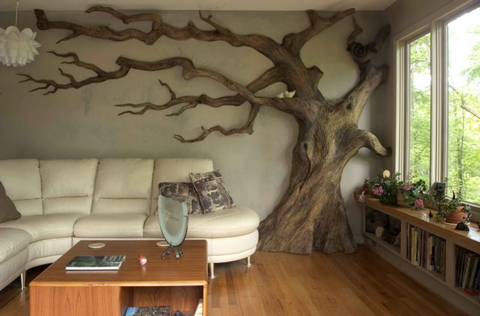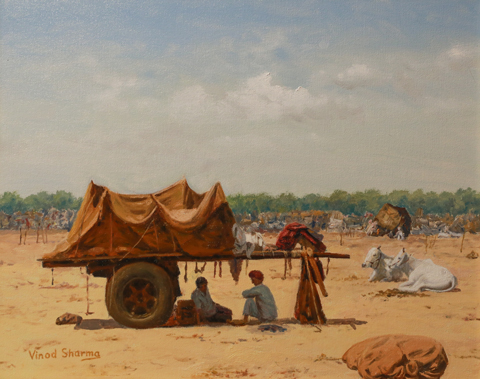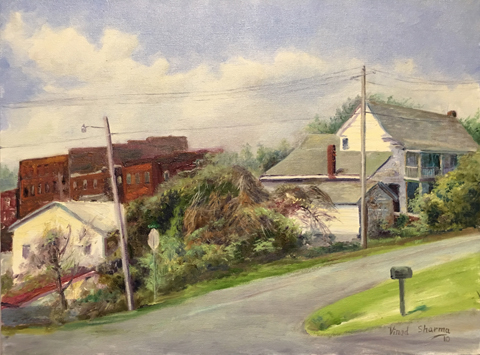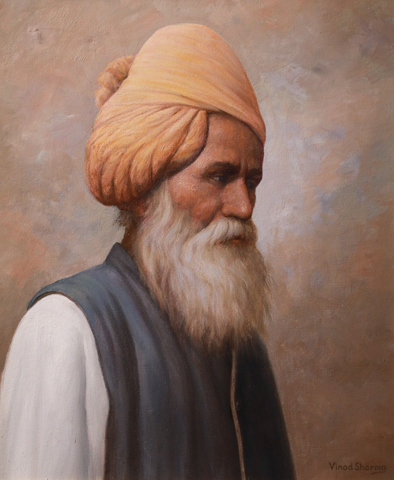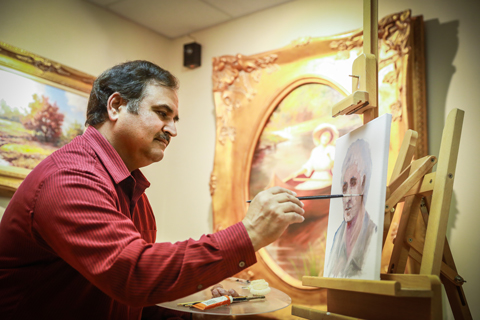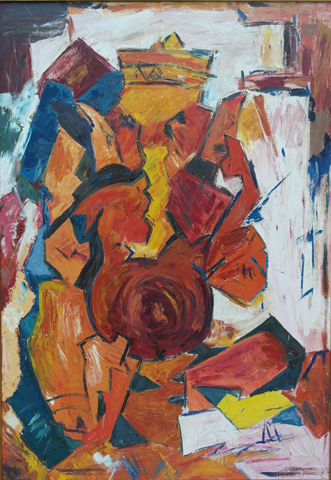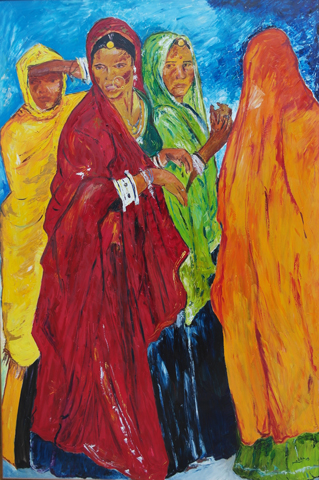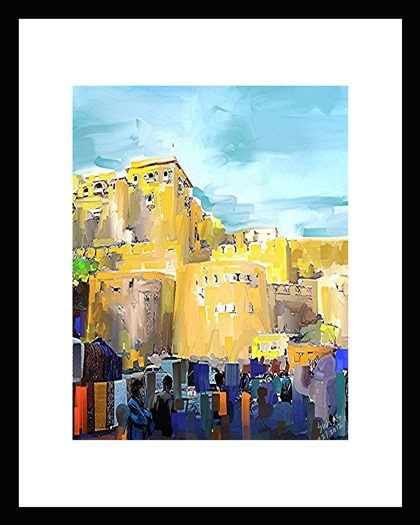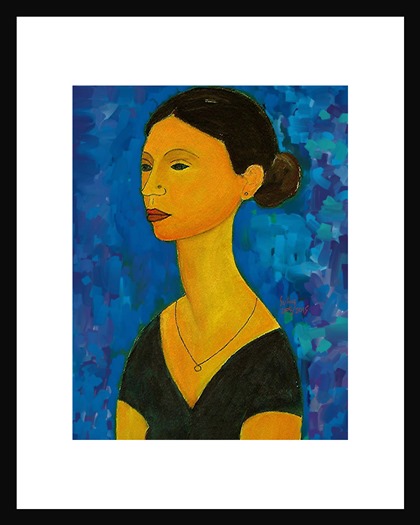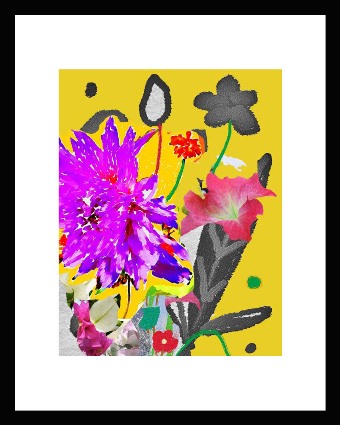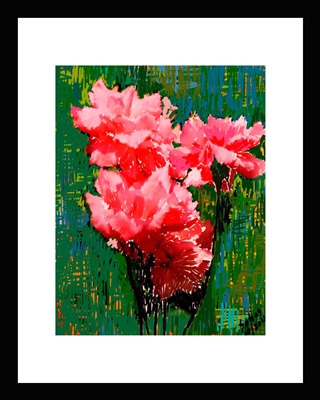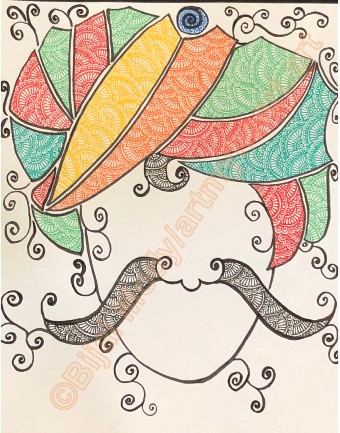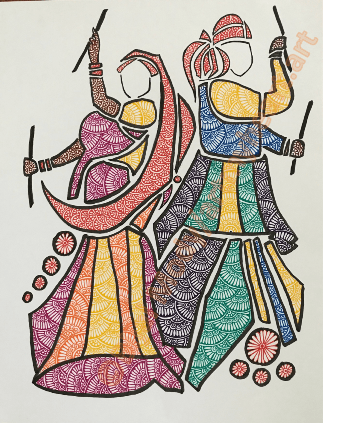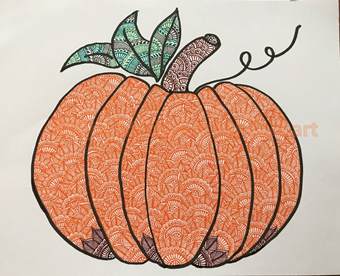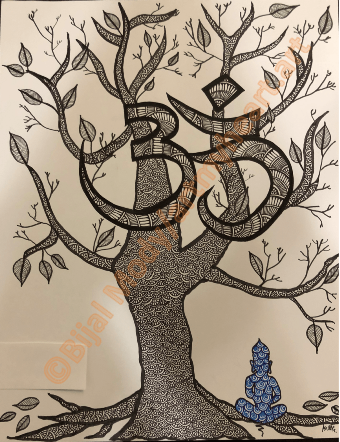ARTlanta
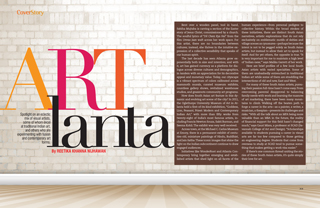
Spotlight on an eclectic mix of visual artists, some of whom excel at traditional Indian art, and others who are experimenting with fusion and contemporary art forms.
Bent over a wooden panel, tool in hand, Sabiha Mujtaba is carving a section of the Easter story of Jesus Christ, commissioned by a church. The soulful lyrics of “Dil Cheez Kya Hai” from the film Umrao Jaan waft across her work space. For this artist, there are no boundaries between cultures; instead, she thrives in the intuitive expression of a collective sensibility that speaks of our human spirit.
The last decade has seen Atlanta grow exponentially both in size and intention; and with it, art has gained currency as a platform for dialogue across diverse cultures and demographics, in tandem with an appreciation for its decorative appeal and monetary value. Today, our cityscape is a vibrant spectrum of colors calibrated across mammoth murals, curated museum exhibits, countless gallery shows, revitalized warehouse studios, and grassroots community art programs.
How does South Asian art feature in this dynamic and evolving art scene of the city? In 2011, the Oglethorpe University Museum of Art in Atlanta held a first-of-its-kind exhibition, “Goddess, Lion, Peasant, Priest: Modern and Contemporary Indian Art,” with more than fifty works from twenty-eight of India’s most famous artists, including Francis Newton Souza, Sakti Burman, and Seema Kohli. The exhibit was very well received.
Across town, at the Michael C. Carlos Museum at Emory, there is a permanent exhibit of centuries- old, miniature paintings of Hindu, Buddhist, and Jain faiths. These iconic images that shine the light on the Indian subcontinent continue to draw engaged audiences.
Initiatives like WonderRoot and Atlanta Contemporary bring together emerging and established artists that shed light on all facets of the human experience—from personal pedigree to collective history. Within the broad strokes of these initiatives, there are distinct South Asian narratives, artistic explorations that do not rely exclusively on emblematic motifs of deities and village scenes as cynosures—perhaps because the intent is not to be pegged solely as South Asian artists, but instead to allow their art to speak for itself. And for yet others, the opposite is true. “It is very important for me to maintain a high level of ‘Indian-ness,’” says Malika Garrett of her work.
Here are brief profiles of a few local South Asian artists with varied specialties. Some of them are unabashedly entrenched in traditional Indian art while some of them are straddling the intersections of old and new, East and West.
For many of these South Asian artists, pursuing their passion full-time hasn’t come easy. From overcoming parental disapproval to balancing family needs with work and learning the nuances of art marketing, there have been many mountains to climb. Walking off the beaten path to forge a career in the arts—as a painter, a writer, a musician, a thespian—presents its challenges and risks. “With all the talk about an MFA being more valuable than an MBA in the future, the reality of financial support for this field hasn’t changed much,” says Gauri Misra, a professor at SCAD (Savannah College of Art and Design). “Scholarships available to students pursuing a career in visual arts are far too few compared to those getting an engineering degree. Students that come from overseas to study at SCAD tend to pursue something that makes getting a work visa easier.”
If there’s one common thread uniting the stories of these South Asian artists, it’s quite simply their love for art.

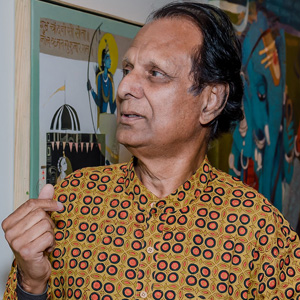
Dinesh Sharma— accomplished artist, art professor, founder of art gallery
“Artists end up on the streets.” Listening to Dinesh Sharma repeat his father’s harsh cautionary warning one can almost see the determined young boy with a passion entirely incongruent to his father’s aspirations for him. “My father was very angry when I told him I wanted to be an artist. He said nobody in our family does that. He did not want to support me because painting was not considered a good subject for a family like mine.”
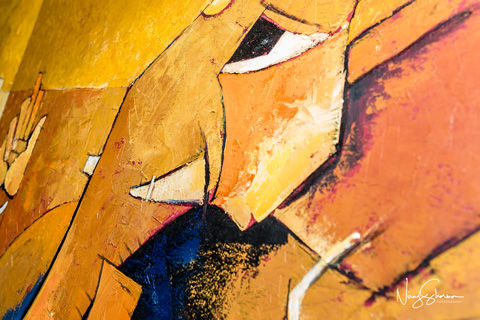
(Right) “Remover of Obstacles.”
Fortunately for Sharma, he was awarded two scholarships—“one by the government and one from the queen of Indore,” he says, proudly. He went on to become a professor of Fine Arts and has since published a book and over 100 papers on culture, art, music, and philosophy. As a traveling guest lecturer on Hindu mythology, Indian art, and architecture, Sharma divides his time between his studios in Atlanta; Orlando, Florida; and Udaipur, India.
“I have traveled to more than 70 countries, and I go back to India very often to teach at different universities.” Listening to Sharma delve into the varicolored facets of Indian art, one recognizes the wealth of knowledge he possesses on the subject, and why he has earned the respect of his peers in India and abroad.
Sharma, along with other art professors, banded together to introduce new techniques of composition and color. However, his journey as a visionary artist came to a grinding halt when the family moved to New Jersey to join their son.
“I thought there was a dollar tree in America. I thought life would be easy. But it was tough to survive.” Sharma worked as a hotel manager for several years—never being able to sell any paintings. However, things changed when “a guy passing by saw one of my paintings and asked me to paint 31 tables for his new Indian restaurant. I thought it was insulting to be asked to paint tables, but it was a matter of money.”
Sharma gives his wife, a former professor and artist in her own right, much credit for being his constant support. “We both worked on the tables. We still work together. We are a team.”
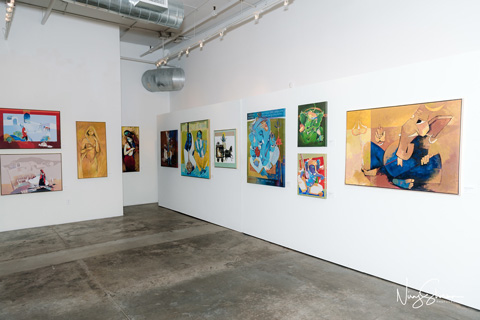
(Left) East India Art Company, Sharma’s gallery in Atlanta.
Sharma’s now well-established East India Art Company is a portal to his body of work that includes modern paintings, murals, and stage and temple design. Deriving much inspiration from the natural beauty of Rajasthan and its people, Sharma’s gallery takes us on a journey through the villages and deserts of this princely state. We discover this region in his depictions of its tribal folks, bright clothing, jewelry, and nomadic lifestyle. The architectural flavor of various cities like Udaipur, Bikaner, and Jaipur can be seen in the background of his many creations.
|
|
|
| “Moonlight.” | “Education of Krishna.” |
Sharma also uses his canvas to celebrate womanhood in all her forms. His keen appreciation for the female form in quotidian motion—cooking, washing, and caring for children—developed as he traveled frequently through Rajasthan to observe the abundance of rural life in the arid desert state.
“The undulating female form carrying pots of water from the rivers has hypnotized my consciousness. The women that inhabit my art are an influence from classical Indian works of romance. This is my homage to the masters of Rajasthani miniature paintings,” offers the artist.

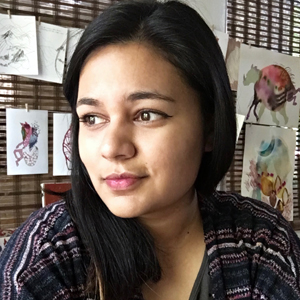
Crystal Desai—artist, outlier
Why would you want to be an artist when you could become a doctor, a lawyer, an engineer, a software developer? Attempting to redraw the family-ordained South Asian blueprint for a successful life is like standing barefoot on sharp-edged rocks, balancing a fishbowl on one’s head with disapproving parents looking on, convinced of the improbability of even a modicum of face-saving success. It takes absolute belief in one’s skills and heaps of courage to do what one is forbidden to do by well-meaning parents.
Desai is one such outlier. “I was trying to stay away from art,” she explains, speaking about her undergraduate work at UGA where she studied Economics in addition to Art, believing, much to her parent’s relief, that she would eventually end up at business school. “But I became an art major by my sophomore year.” The decision did not sit well with her well-intentioned parents.
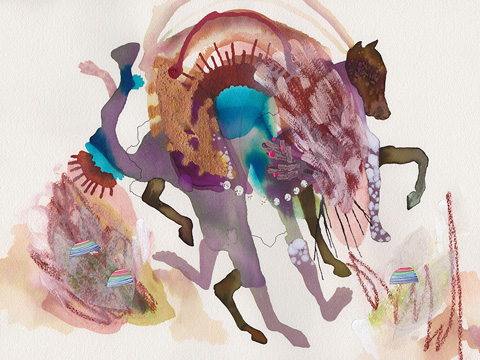
(Left) "Wildheart.”
Sitting on a peacock blue shag carpet in her private studio space capsuled within a warehouse-turned-artscape in Atlanta’s Westside, Desai talks with guarded cheer about the fellowship that bought her the freedom and resources to be an artist. “I got a fellowship with MINT, a nonprofit, through their program called Leap Year. I have this studio space for six months, a solo show in December, a stipend, an art residency at Hambidge [in Rabun Gap, Georgia], and a mentor to guide me.” The sense of achievement and delight seems to have overcome the residual angst of the journey that brought her this far. “I am getting to a place of being more joyful,” she adds, optimistically.
|
|
|
| “Ancestor’s Voice.” | “Portrait With Inner Landscape.” |
The deep-rooted, hard-won sense of female empowerment that echoes in the complex narratives of women in Desai’s family is evidenced in her multimedia work replete with textures. She was introduced to this art form by her brother, whom she describes as “artsy.” Fashioned from ink, collage, nail polish, beads, paint and other motley elements—the seemingly spontaneous layers are deeply intuitive in assembly and application. “I add on materials gradually.”
Desai is learning to use multiple social media platforms to market her work. “I know a lot of successful artists who self-market, and I really need to get out there,” she says, more by way of personal reminder. “Engaging face-to-face at art-related events can lead to opportunities for showcasing one’s work, which eventually translates into sales.”

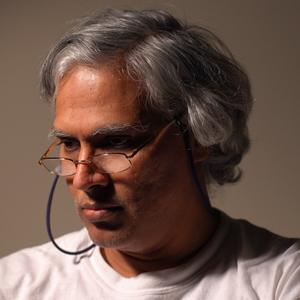
Dr. Sivananda Nyayapathi—an “Associate Living Master” of art
A signature member of the prestigious Oil Painters of America, and the National Oil and Acrylic Painters Society, designated as an Associate Living Master by the Art Renewal Center—these are only a few accolades that confirm Dr. Sivananda Nyayapathi’s caliber as an accomplished artist—though he is quick to remind us that art per se is not his profession. “I have a career in the IT industry.”
|
|
|
| “Graceful”—Grand Prize Winner, CFUMC Fine Arts Festival. | A portrait sketch of the Late Dr. P. V. Rao, a pioneering Renaissance man of the Atlanta Indian community. |
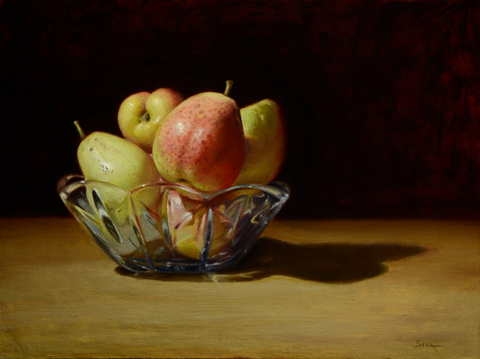
(Right) “In the Pink,” a still life.
Nyayapathi conducts art classes on weekends. “Some of my students have already been exhibiting their works in juried exhibitions,” he informs with pride. Perhaps because he himself has had the opportunity to work with world-renowned artists like David Leffel and Daniel Greene, whom he describes as “kind, giving and encouraging,” Nyayapathi endeavors to pass on his expertise in the techniques of traditional representational style.
Like every one of us, he began drawing as a child. As stated in the introduction on his website, sivanandafineart.com, “Art is the innate nature of humans. It is one of the most natural ways of communication…. As the kid grows, he or she develops other interests and drawing takes a back seat.” When asked to elaborate, he says, “In India, classical music and dance have very much been part of the society we grew up in, but drawing and painting, as an art form, has not been given much importance.”
Perhaps our collective apathy factors into our lack of appreciation for fine art as a decorative element for our home. “There was not much of a market in India for painting. Mostly people purchased paintings of deities by Raja Ravi Varma—and not for their artistic value.” Dr. Nyayapathi does occasionally see second- and third-generation Indians purchase art from an investment perspective in addition to buying gold and dabbling in the stock market. But he makes no efforts to sell his works. “I just love to paint and so I paint.”


Manty Dey—melding skills and creativity
While skill cannot replace passion, it undoubtedly strengthens the creative muscle. Formal training in fine arts equips aspirants with impressive tools and techniques to build upon any rudimentary skills they may have acquired in their formative years.
Manty Dey is an India-born artist who has honed her inherent talent throughout her academic years. With an MFA in Drawing and Painting from UGA and a BFA in Drawing and Painting from Georgia State University, Dey’s caliber is evident in her dense chromatic abstracts rendered in varicolored materials that are seemingly in constant motion. She is the winner of the 2016 FCAC Fellowship from the Hambidge Center for the Creative Arts and Sciences, and WonderRoot’s Walthall Fellowship.
Born in Kumarghat, India, she grew up in a home surrounded by Indian textiles, embroideries, and handmade clothes. “I internalized a specific visual language from these materials which carry into the abstract imagery and forms in my work.” The 30-year-old Dey moved to Georgia with her family when she was six. She credits the strong arts program and engaged teachers during her public school years for cultivating her interest in the arts. “In high school, I attended the Governor’s Honors Program for art. It was an incredible summer program that solidified my choice to major in studio art in college.”
|
|
|
| “Drops,’ a sculptural painting. | “Wave 4,” Acrylic sheet. |
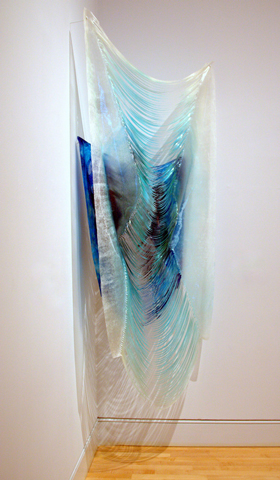
(Left) “Offerings II,” a paper form.
From a marketing perspective, she recognizes that the most essential way to gain an audience is to consistently showcase her work, network with fellow artists, and be part of the local art ecosystem. “I sell my work through art shows and painting commissions. Like most artists, I use Instagram to share my work, process, and inspiration. It is a great tool to find new artists, galleries, and designers.”
A visit to her virtual gallery at MantyDey.com is a visual delight. The alive-and-ticking effect of her large sculptural paintings, acrylic on vinyl and panel and other mixed media compositions that shift between two-dimensional and three-dimensional forms is stunning. Dey is currently exploring the dimensional possibilities of acrylic paint and how to extend it beyond the surface. “I construct paintings by meticulously cutting and draping the surface, transforming the flat painting into a sculptural form. The paint is a physical material, the color has a glow, and its cast shadows create volume. All of these elements activate the surface. I am thinking of ways to make each painting breathe and vibrate.”
She delves deeper with palpable enthusiasm into the secrets of her craft: “Each dissection unveils traces of intentional and improvised gestures as they accumulate and dissolve over time and temperament. These physical elements, combined with symmetry and gradation of color, offer a quiet moment for observation.”

Sharmila Roy—passion meets prudence
Kolkata-born Sharmila Roy never deposited the check her parents gave her to enroll in music class at a cultural center in her hometown near Kolkata. She hated practicing singing. Instead, she registered for an art class, which served as Roy’s introduction to charcoal, pencil, and watercolors. She continued to nurture her childhood passion for drawing through architectural engineering in undergrad, while acquiring a Masters in architecture and then working as an architect in the U.S.
|
|
|
| “A New Day.” | “Morning Light.” |
Roy’s moody palette of muted shades rising like mist off of large 30 in. x 40 in. canvases has a soothing effect. “I like to take the viewer on a journey of their own,” she says, pointing to one of her ethereal paintings depicting an expansive seascape. “I would love to go bigger, 48 in. x 48 in.” she says wistfully, imagining the world beyond the ocean in her mind’s eye. “I have photographs from India that I would like to paint in abstract form.” But Roy knows well the aesthetic sensibilities of the demographics within which she is ensconced. “There isn’t a market for it.”
Speaking of her clientele, she says Indians don’t typically buy art. “We’ll buy saris that cost lakhs, but we won’t spend money on a painting that we can enjoy every day. It is not in our DNA.”
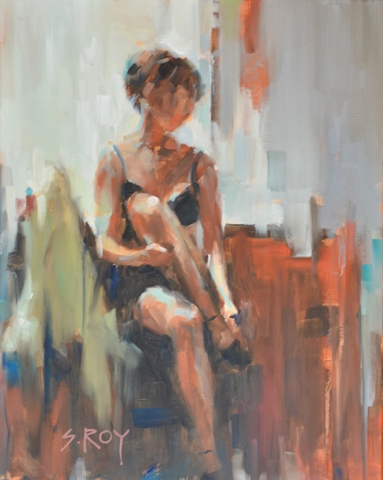
(Left) “Ready for the Evening.”
Commission work often comes her way, and while she can tune into the client’s vision, it is the abstracts—“which tend to be a hard sell because people sometimes have a tough time relating to it”—that she enjoys the most. “I like to capture a mood in my nonobjective abstracts. I think in color. If my daughter is telling me a story from school, if it is good, I might think blue pastel colors; if it is not, I might see orange.”
An in-house studio tucked away in what could pass for a chalet in the woods is Roy’s haven in Atlanta. Her husband and two daughters form the support system that affords her the mindscape to revel in color, in addition to providing the technical tools necessary for entrepreneurial success. “My husband helps me with my website, and my daughters showed me how to get on Instagram,” she quips. “I heard about this artist on NPR who does installations and uses Instagram to show her work. I came running home and asked my older daughter what the thing is!”
Since then, the image-driven app has helped Roy gain exposure in ways that would have been impossible a decade ago. “I get calls for shows I did not even apply for!” The Marietta Square Gallery, Cobb County Gallery, galleries in Buckhead and Miami Circle, and the popular Spotlight on Art show at the Trinity School—Roy has displayed her figurative works and contemporary abstracts rendered in soft, pensive brushstrokes across the city with much success.

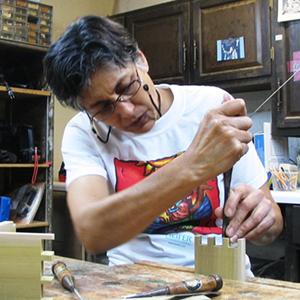
Sabiha Mujtaba—sculpting a place for herself as an artist
Born in Karachi and raised and educated in England, Sabiha Mujtaba studied sculpture at the Hammersmith College of Art. She moved to Atlanta in 1981, and after an apprenticeship with Sutherland Studios, she set off on her own with Chrysalis Woodworks where she chisels movement into the static composition of wood, resurrecting it into new avatars as singular pieces of functional furniture and storyboard panels. Mujtaba’s fluid creations each have a story to tell. The dark slithering legs and sentinel back of the “Naga, Naga—Guardian Protector” chair welcome and warn, the ever so gently cascading folds on the “Bench with Sindhi Shawl” hark of warmth, and the life-like trunk and limbs of a floor-to-ceiling installation “Tree” infuses alfresco splendor within a confined space.
|
|
|
| “Naga, Naga—Guardian Protector.” | Bharatnatyam Dancer Chair, details. |
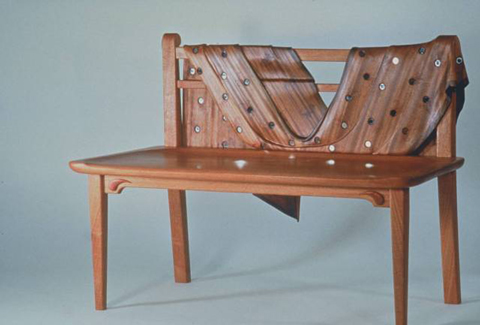
(Left) “Bench with Sindhi Shawl.”
Most of Mujtaba’s work is client-commissioned. “For the past year-and-a-half, I have been working on the Stations of the Cross,” she explains, pointing to the panel she is leaning over. “It is the story of Easter Friday, and Saturday and Sunday.” Mujtaba, a Muslim unversed in Christian conventions, spent much time learning the Biblical story from Father Michael Woods at the All Saints Catholic Church in Knoxville, Tennessee, the final home for what is taking shape as we speak. A keen appreciation for her South Asian heritage renders Mujtaba’s heart and mind open to understanding and appreciating mores different from her own. “Our inherited sensibilities get filtered into our work as artists. It all comes together.”
|
|
| "Tree." |

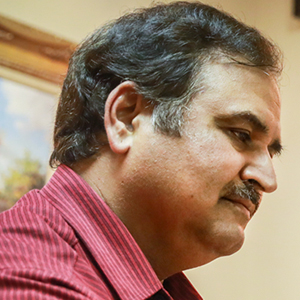
Vinod Sharma—gifted by nature and heredity
Fifty-two-year-old Vinod Sharma moved from Jodhpur, Rajasthan, to Atlanta with the purpose of enhancing his artistic skills and gaining a wider audience. Since relocating 12 years ago, Sharma has found success on both counts.
|
|
|
Sharma’s storyboards run the gamut from the arid yet stunning landscape of the desert state of Rajasthan, indigenous animals, scenes of bucolic life, portraits of dwellers in traditional garb—men in turbans and women in ghagra cholis, and festivals like the Pushkar mela. Every spread of color on his canvas, even when playing the quiet role of a backdrop, is pivotal in etching the complete narrative. Pigmented with precision and purpose, his tableau has a photographic quality that is evident in his oil paintings, watercolors, and the occasional acrylic.
“People often say, ‘You have a gift,’” Sharma informs, talking about people’s reaction to his remarkable work, “but I think anyone, at any age, can become an artist. It is all about studying art.” Sharma was exposed to art early on in his life. “My grandfather, like my father Mohan Lal Sharma, who is a well-known artist in India, was an artist also,” he says, when asked about his reason for acquiring a fine arts degree in college. Finding work in India as an artist was easy, given that his father had established himself as an artist, and Sharma joined the family business, so to speak.
|
|
|
| This portrait of a Rajashtani man was a finalist in Atlanta Portrait Society’s 2018 exhibition. |
As part of the Suwanee Association of Art, Portrait Society of Atlanta, National Oil and Acrylic Painters' Society (NOAPS), and the Portrait Society of America, Sharma is able to engage with other artists while gaining visibility for his own works. Recently, Sharma set up SFA Gallery in Cumming. “It was a dream my father and I shared—to have our own gallery. We want to show work of local artists, and we may even get artists from India. This is an idea I want to develop,” he says with enthusiasm.
Lamenting the generic, cookie-cutter prints that are typically seen on the walls of Indian-American homes, Sharma says, “When we sit, our eyes travel to walls, not floors,” he says passionately. “More attention should be given to what is on our walls.”


Malika Garrett—the joy of giving
Painters of repute are often called upon to lend a brush to support local and international charities in their ameliorative endeavors. While there is no personal monetary gain in such altruistic partaking, there is boundless joy to be accrued, as Malika Garrett would have you know.
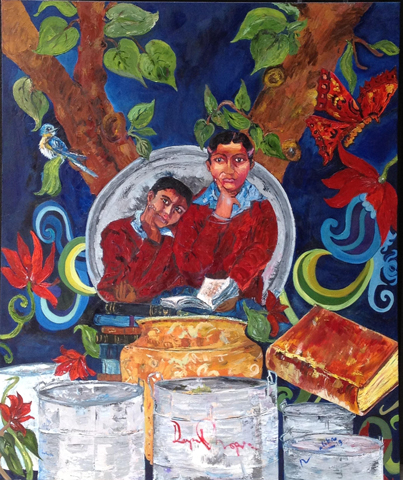
The Kolkata-born great-grandniece of scientist Jadgish Chandra Bose, Malika Garrett grew up immersed in the arts. “I always loved drawing,” she says. “I was forever sketching on any paper I could find. My most treasured gifts were pencils, erasers, crayons, and markers! I won the class art prize every year in my school in Kolkata.” Garrett went on to earn a BFA in Visual Arts from Wesleyan College in Macon, but ended up in sales and worked for large corporations like Kodak and Coca-Cola. All along, the enterprising, mercurial artist-at-heart continued to paint. And it is through her art that Garrett has been recognized, in ways that she finds most rewarding.
Her painting, which Deepak Chopra also signed, raised $50,000 for Akshaya Patra, a nonprofit focused on addressing childhood hunger in India. “In addition to raising money for Mother Teresa’s Missionaries for Charity, I taught classes to the children of the household help. Robin Raina [the successful entrepreneur and founder/CEO of Ebix] and I partnered together for ‘India on Canvas,’ and then with Shashi Tharoor in 2008 for the same charity.”
(Left) The painting, signed by Deepak Chopra, that raised $50,000 for Akshya Patra, a nonprofit.
|
|
|
| “Ganesh.” | “Bishnoi Women.” |
Garrett’s vibrant, dynamic images are visual storybooks. “My work is mostly about the people of India—their lives, their strength, simplicity, and courage.” A keen observer, she captures the minutiae of quotidian life in India with radiant colors on canvas. “It is very important for me to maintain a high level of ‘Indian-ness.’” Vivid and vivacious, Garrett’s large portraits of provincial denizens—whispering women and curious-eyed men—invite the viewer to engage in a visual dialogue. Garrett finds much inspiration in the happy faces of people who lead onerous lives with little in the way of worldly possessions. “They have inspired me to survive, despite the many odds I have faced as well.”
Her positive outlook has earned much kudos from Oprah Winfrey, whom Garrett counts as a dear friend. Her profile on the OWN blog reads, She is love and light, and it shows up radiantly on canvas.

As a people who share a multi-layered cultural heritage of soul-stirring classical music, myriad dance forms, vernacular literature, glorious temple sculptures, world-famous architecture, and luxurious textiles, the onus is on us to applaud those who have the chutzpah to “work with their hands”—with brushes and chisels—to remind the world to look at the beauty within each of us. If ever there was a time to pursue and preserve the arts, it is now, in an increasingly automated world consumed and crippled by divisive politics and fanatic ideology. The rips in our social fabric can be repaired not with rhetoric spewing, but by weaving the common threads of our shared humanity—and by looking at art as one would a mirror.

Website Bonus (below): 1. Suhas Sengupta captures the eclectic, bohemian spirit of areas like Little Five Points and Ponce City Market in his “Atlanta Neighborhood Series.” 2. Bijal Modi’s creative expansion of henna—from just body adornment, most seen in bridal mehendi, to other applications such as greeting cards, bookmarks, wall art, and more.

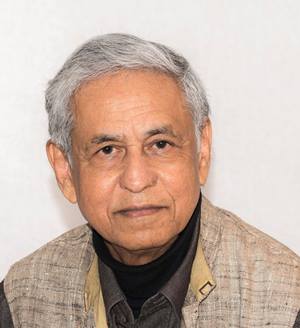
Suhas Sengupta—the challenge of art marketing
Suhas Sengupta, who describes himself as an “ancient man born in West Bengal,” graduated in Architecture from IIT, Kharagpur and worked in India for a few years before moving to the U.S. to further his career. Looking back on his timeline he points to his high school years as a starting point for painting. “I participated in local art exhibitions at that time.” Sengupta continued to paint while working as an architect, and since his retirement, spends most of his time reveling in color.
|
|
|
“I started with abstract style landscape and human figures and then to pure abstract forms. My painting medium was acrylic on canvas or on Canva-paper. I have also done some large painting using dry pastel on wet canvas.” More recently, evolving with the times, Sengupta has learnt to employ digital tools. “Now I have added graphic art to it in a very unconventional way, and that is my style of art,” he explains. An ace lensman in addition to being a painter, he uses photographs to fashion his graphic art.
In his “Five Points Area,” part of his “Atlanta Neighborhood Series,” Sengupta captures the eclectic, bohemian spirit of the area with a clever collage-like juxtapositioning of images of people and places. In his “graphic art compositions,” of the “Ponce City Market,” he inserts his paintings within the mosaic of photographs lending a cutting-edge, urban aesthetic to the artwork that mirrors the cosmopolitan vibe of the revitalized space along the Beltline that once served as the City Hall.
|
|
|
“My South Asian heritage has no reflection in my artwork, except when I do female figures,” he says, when asked about the influence of his ethnicity in his choice of subject and palette. Sengupta has thus far sold several pieces for charity. “If I get the opportunity I would love to sell my artwork for charitable purposes.” He has in the past showcased his work in galleries, but marketing is often problematic. “Not being an outgoing personality and not having a salesman’s skills, it is always a challenge for me to promote my work.” Sengupta may not have the gift of the gab to engage in real-time with possible patrons, but through Facebook he is able to display his vibrant work in a virtual gallery. Colors of “Fantasyland,” and “Lost Spring” pop up on the screen like crayons emerging from a new box, garnering praise in the modern way of clicks and comments. The retiring “ancient man” clearly has an astute mind and a youthful heart.

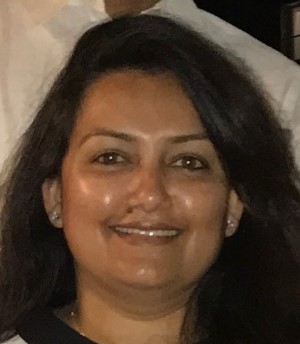
Bijal Mody—henna specialist
The deep shades of saffron, the singular earthy smell, and intricately detailed patterns—mehndi is an iconic and enduring motif and a hallmark of the ethnic Indian identity. Henna as a form of body adornment has historically been associated with joyous celebrations like weddings and festivals such as Teej. Forty-year-old Bijal Mody translates the intricate beauty of this age-old tradition on various surfaces thereby making it more visible and viable. A mother of two teenage children, Mody has the steady hand of a surgeon when she channels her time-honed expertise as a henna artist on paper.
|
|
|
| “Turban." | “Navratri." |
“Bridal mehndi was my starting point in this country almost two decades ago,” Mody explains. “I use mehndi designs as an expression and inspiration for my custom ink artworks.” Bookmarks, greeting cards, decorative wall art—the daedal ink-on-paper creations have the feel of Madhubani, the distinctive art form developed by rural women in the Mithila area of Bihar. The web-fine lines fall into labyrinthine formation rendering the unembellished spaces thus generated as integral to the thematic design as the contiguous millimeters inked by the artist.
Looking back, Mody speaks of having been immersed in the arts all along, “be it Bharatanatyam and folk dances as a kid, learning the art of mehndi and rangoli, helping my kids and their friends with their art or school projects, making communal rangolis during major festivals, or entering competitions for art and crafts through the school and community.” “Art in one form or another has always been an integral and intrinsic part of my family. My mom is an amazing artist—she works in pencil sketching and portraits.”
|
|
|
| “Pumpkin." | “Tree." |
Mody is eager to find her footing and earn credibility as an artist, and to that end, she has thus far stayed close to her roots, showcasing distinctly Indian artistry on common use items like greeting cards and customized nameplates. “I am always trying to think of innovative ways to market my art,” she says. Perhaps the greater visibility accrued on account of open display and circulation of these products will give this delightful art form enhanced recognition and market value. “Translating the said audience into sales is an ongoing and an uphill struggle. So far, I have been focusing on my art and hope it speaks for itself—as to the quality and workmanship and love poured into each piece.”
Reetika Khanna Nijhawan is a former Associate Features Editor for ELLE DECOR, India, and the author of Kismetwali & Other Stories (shortlisted for the Townsend Prize for Fiction). Her work has appeared in the Atlanta Journal Constitution and ATLANTA Magazine. www.reetikanijhawan.com
Enjoyed reading Khabar magazine? Subscribe to Khabar and get a full digital copy of this Indian-American community magazine.
blog comments powered by Disqus




